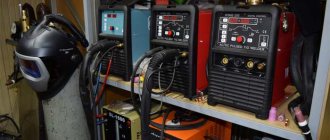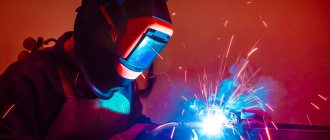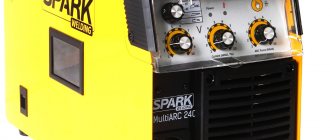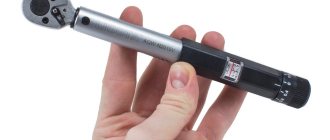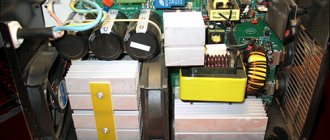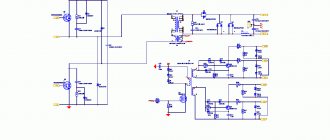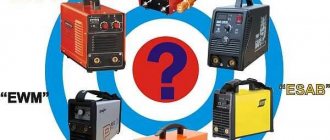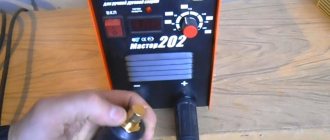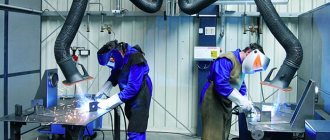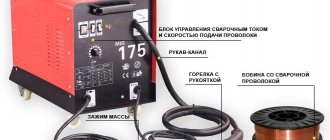A real technical revolution has taken place in the world of welding. And this is an excellent fact, because this revolution consists of the appearance on the market of a huge number of new, convenient and safe devices for welding of various types. They allow even beginners to work effectively: the threshold for entering the profession has been lowered. This is a very positive development.
But every revolution brings new demands: you need to be aware. You need to know and understand new equipment and gadgets, understand the essence of new technologies, and be able to choose the best models of devices based on parameters that are important to you. We offer you to understand all the welding machines that exist today.
Classification and main types of welding machines
Classification of welding machines.
To begin with, let’s clarify all the known abbreviations associated with welding; we cannot do without them in the future.
- AC and DC: This is an English abbreviation that stands for alternating current and direct current respectively.
- TIG – manual welding with argon and tungsten electrode.
- MIG and MAG – semi-automatic arc welding with consumable electrode wire with the supply of inert or active gas.
- PV is a Russian abbreviation for “on duration,” indicating the time during which the device will operate without overheating.
- MMA – manual arc welding with stick electrodes.
The types of welding machines are as follows:
- transformers;
- rectifiers;
- semi-automatic;
- inverters;
- generators running on diesel fuel or gasoline.
Transformer - a veteran of retirement age
Many craftsmen consider transformers to be obsolete devices whose place is in recycling plants. There are other points of view. Let's try to figure it out.
This is truly the oldest professional welding machine used in welding. At the same time, it is the simplest in its design. The main task of the transformer is to convert electric current, or more precisely, to reduce the voltage to an acceptable level for welding.
The design of the transformer is extremely simple: one of the most important elements is the core. There are two windings on it - primary and secondary. One of them works as static, the second moves relative to the first, and one winding moves against the background of the immobility of the other.
This process ensures a decrease in current. In this area there may be different options for the mechanism of action, but the main thing remains the same: reducing the current voltage so that the current supply to the arc is stable.
Welding transformer.
The peculiarity of transformers is only alternating current at the output. This fact does not speak in favor of the quality of the weld. The fact is that with alternating current, metal tends to splash in different directions. You need to cook using rutile or calcium fluoride electrodes, the diameter of the most optimal sections is about 1.5 - 2.5 mm.
Electrodes must be selected based on the maximum current and voltage in the device.
Like any other technical device, transformers have their advantages and disadvantages.
The positive properties of the welding transformer are as follows:
- They are simple in design and therefore easy to maintain.
- Extremely high reliability.
- Inexpensive in cost.
- They have quite high performance - up to 90% efficiency.
Now let's compare them with the disadvantages of a transformer:
- Massiveness: heavy weight and large dimensions.
- High energy consumption, since a lot is needed to preheat the device itself. Fan cooling also requires a lot of energy.
- High dependence on mains voltage: when it decreases, the quality of the output welding current decreases significantly.
And one more important factor. In order to cook using transformers, you need quite serious skills. This is not easy for beginners; they often have difficulty maintaining a high-quality arc.
So, what do we have with regard to transformers: serious dimensions, high energy consumption, preliminary welding skills are required. Arc stability and seam quality are not always ideal. But they are cheap in cost. Do they have prospects? Yes, of course, these prospects fade over time.
The most appropriate definition would be “outgoing devices.” Transformers are suitable for those for whom the criteria of low price, durability and reliability are most important.
The best professional semi-automatic welding machines
We have compiled a rating of the best professional semi-automatic welding machines. We studied the reviews in detail and, based on them, identified the advantages and disadvantages of each model.
Aurora PRO Ultimate 500 IGBT
Aurora PRO Ultimate 500 IGBT
The ULTIMATE series is a high-performance equipment for semi-automatic MIG/MAG welding, as well as full MMA welding across the entire range.
The device belongs to the class of industrial equipment intended for heavy industrial use. Decompact version with a powerful 4-roller feed mechanism. The kit includes a bundle of wires to the power mechanism - 15 meters, which allows you to maximize the working area. The easy-to-set up control panel has all the most important functions for the quality execution of any production task. There is customizable crater welding mode, gas purge, 4-stroke torch mode, polarity reversal switch, etc. The advanced design of the power section based on modular IGBT technology ensures the reliability of this equipment for many years. 100% operation with maximum currents ensures stable operation of the welding station.
Pros:
- Power.
- Select the welding mode - MIG/MAG or MMA.
- Selecting wire diameter.
- Build quality.
- Reliability.
There are no cons.
Buyers are completely satisfied with the operation of the device, emphasizing the completeness of functionality, quality and power.
Cedar MIG-350GF
Cedar MIG-350GF
The most productive device. Serves for semi-automatic welding under shielding gas conditions MIG/MAG and for full-fledged high-quality manual arc welding with a MMA stick electrode. The device has a customizable crater filling mode and a 4-stroke burner operating mode. Equipped with a unique inductor electronic circuit, which can accurately control the working process. The model is portable, compact in size, and has an open external feed mechanism. This allows it to be used in hard-to-reach places due to the possibility of extending the cable package to significant lengths.
Pros:
- Possibility of using cored wire.
- Selecting the diameter of the welding wire.
- Advanced IGBT technology.
- Power.
- Equipment.
There are no cons.
Users are satisfied with the model and recommend it for purchase. They emphasize the absolute correspondence between price and quality.
Brima MIG-350
Brima MIG-350
The model is designed for welding with solid wire in shielding gases (this welding method in accordance with ISO 4063-90 has the following abbreviation - MIG Metal Inert Gas, MAG Metal Active Gas) of materials such as carbon and alloy steel. Active gases (carbon dioxide, gas mixture) are used as shielding gases when welding MAG, which take part in the formation of the welded joint, and inert gases when welding MIG (argon, helium), which do not interact chemically with metals and practically do not dissolve in them. Thanks to the protection, the welding zone is not exposed to the harmful oxidative effects of the environment, and the quality of the welded joint also increases dramatically.
Pros:
- Power.
- Good equipment.
- Large range of welding current.
- Convenient adjustment.
- Multifunctionality.
Minuses:
- Weight - more than 30 kilograms.
- Chinese assembly.
Experts recommend the model for purchase, noting that the device has high power, metal penetration is excellent, and the maximum welding current reaches 390 A.
Telwin MasterMIG 300
Telwin MasterMIG 300
The semi-automatic welding machine TELWIN MASTERMIG 300 is a convenient device for efficient welding work. The advantage is that the current can be precisely adjusted. For ease of transportation, the structure is placed on a platform with swivel wheels. Durable housing with perforations to remove warm air increases switching time and extends service life. The kit includes the necessary cables to start welding.
Pros:
- High strength.
- 4-roller feed mechanism.
- Spot welding time adjustment.
- A large number of settings.
- Reliability in operation.
There are no cons.
Users are satisfied with the device, no negative reviews were found. They note the excellent performance and reliability of the model.
BRIMA MIG-350
BRIMA MIG-350
The model is designed for welding with solid wire in shielding gases (this welding method in accordance with ISO 4063-90 has the following abbreviation - MIG Metal Inert Gas, MAG Metal Active Gas) of materials such as carbon and alloy steel.
Pros:
- Power.
- Good equipment.
- Large range of welding current.
- Convenient adjustment.
- Multifunctionality.
Minuses:
- Chinese assembly.
Experts recommend the model for purchase, noting that the device has high power, excellent metal penetration, and a maximum welding current of up to 390 A.
Fast and Furious 502
Forsazh 502
DC welding machine FORSAZH-502 for industrial use is designed for mechanized and semi-automatic welding (MIG/MAG mode) of steel materials, parts and assemblies.
In the “MIG/MAG” mode, welding is performed with solid or flux-cored electrode wire with a diameter of 0.8 to 1.6 millimeters in a shielding gas environment. The device can also be used for manual electric arc welding (MMA mode) with piece fusible electrodes of any brand with a diameter from 1.6 to 5.0 millimeters. The model can be used as a power source for argon arc welding of parts and materials made of stainless steel and copper alloys (TIG mode) with additional equipment.
The device provides:
- stability of the welding process;
- the ability to power the welding machine from autonomous mobile power stations;
- protection against overheating, overload or accident;
- high-quality seam formation;
- performing welding seams in any spatial positions.
Pros:
- Reliability.
- Build quality.
- Convenient controls.
- High strength.
- Accuracy of indicators.
Minuses:
- Only for three-phase network.
- Lack of adjustable inductance function.
Users are delighted with the performance of the model, experts recommend it for purchase.
The straightener is a real compromise
Straightener for welding.
This type of device is a pure technical compromise. They come in two types: silicon and selenium. In its design and principle of operation, it is exactly in the middle between a veteran of the welding movement transformer and a new generation device in the form of an inverter.
The rectifier design is based on the same transformer. But it is accompanied by additional elements: a rectifier unit, which can be either a thyristor or a diode. The main thing is that the rectifier helps to obtain constant current, unlike a transformer.
Direct current passes through the secondary winding towards the rectifier unit. If the unit is also equipped with a choke, the welding current and other indicators can be adjusted.
All additional accessories that equip the rectifier are aimed at only one thing: increasing the stability and continuity of the electric arc. After all, a good arc gives a high-quality seam as the final result.
And another very important advantage of the rectifier is its ease of operation: beginners without much experience can work on it.
Now the advantages of the rectifier point by point:
- Opportunity for beginners to operate the device.
- The result is high quality welding seam.
- Ability to cook cast iron and non-ferrous metals if you use suitable electrodes.
- You can cook stainless steel and low-alloy steels with special electrodes.
- Stable and continuous arc.
- Wide functionality that allows you to use rectifiers, including for home welding on the farm.
- Relatively cheap.
The disadvantages of rectifiers are almost the same as those of transformers: large dimensions, mains voltage drop and high dependence on it. It should be noted that many manufacturers of household electrical equipment are slowly reducing the production of rectifiers. So we can talk about the quiet maintenance of these devices in the future.
Rectifier welding machines - how they differ from transformers
To increase the efficiency of welding work, transformer devices were modernized, resulting in the appearance of rectifiers. A distinctive feature between transformer welding and a rectifier is that the arc is created not with alternating current, as in the first case, but with direct current. Not only is it easier to weld with direct current, but the seam is also of much better quality.
To make a rectifier out of a transformer apparatus, a diode bridge consisting of silicon or selenium diodes was added to the design of the step-down transformer. Due to this bridge, alternating current is converted into direct current. DC welding allows you to obtain a stable arc and also eliminate metal spattering. Any type of electrode is suitable for working with rectifiers.
Rectifier welding devices have contributed to the expansion of their scope of application. With their help you can work not only with low-alloy steels, but also cast iron, non-ferrous metals, stainless steel, etc.
This is interesting!
Rectifier welding machines use not only diode, but also thyristor units, which help convert the incoming alternating current into direct current.
Based on the above, a number of the following advantages of rectifiers for welding should be highlighted:
- Easy to use. Unlike transformer devices, beginners can easily learn to work on rectifier installations
- Getting a better quality weld
- Extended list of types of metals that can be welded using a rectifier
- Relative cheapness, which is due to their design features
If we talk about disadvantages, rectifiers also have them. Their main disadvantage is that they have the same large dimensions as transformer ones. In case of input voltage fluctuations, there is a negative impact on the quality of the welding joint. Despite the small number of disadvantages, rectifier welding machines are not often found today. Although their production continues today, it is a matter of time, since more advanced types of welding devices have been developed quite a long time ago.
This is interesting!
Rectifier devices are suitable for that category of people who have a limited budget for purchasing a device, and at the same time want to learn how to use it.
Where there is a semi-automatic machine, there is argon
Semi-automatic welding machine.
Semiautomatic machines are specialized types of welding machines for electric arc welding under the protection of inert gases. Mostly it's argon, of course. An additional option for using semi-automatic machines is wire welding: this technology does not require gas protection.
The essence of the process is the exit of the wire from the hose in the holder with the simultaneous exit of the gas mixture. During welding, the wire is in a protective gas environment; it melts under the action of an electric arc. The current and wire feed speed are adjustable.
In terms of their design, semi-automatic devices are more complex than transformers or rectifiers. But they are more convenient to use. These are the favorite devices of craftsmen in auto repair shops, especially in body repair. Semi-automatic welders are also very popular among amateur and handicraft welders.
These are the parts that make up the design of a semi-automatic machine:
- Our old friend transformer.
- Another old friend is the rectifier.
- Special drive for wire feeding.
- Cylinder with inert gas.
- Gas burner with sleeve.
We have already written above that the semi-automatic machine is capable of welding without gas protection. In this case, the protective role is played by flux-cored wire. In principle, this is the same melting wire, but thanks to the flux component, it burns with the release of a cloud of protective gas. This cloud protects the weld pool from oxidation by air no worse than external argon or other inert gas.
The functions of the flux component of the welding wire do not end there. It contains elements that add stability to the electric arc. With this wonderful “fluxing” you don’t need a gas cylinder. But flux-cored wire costs much more than regular wire.
The choice of gas depends on the nature of the metal being welded. Iron cooks well with carbon dioxide. Steel prefers a gas mixture of argon and carbon dioxide. Well, it is best to work with aluminum under the protection of pure argon.
An important factor is the “legitimacy” of gas cylinders: you need to purchase only proven and reliable copies. There can be no talk of saving money on the quality of gas and gas mixtures for welding. Anything but gas.
Semi-automatic with gas cylinder.
Advantages of semi-automatic machines:
- There is practically no spattering of metal during welding.
- The result is high quality welding seam.
- The device is quite effective - it has high efficiency.
- Ability to weld thin sheet metal.
Well, there are much fewer disadvantages:
- High consumption of materials: wire, gas mixtures.
- Considerable cost, especially for flux-cored wire.
The best household semi-automatic welding machines
We have compiled a rating of devices that will help you choose the best semi-automatic welding machine for your home.
Svarog REAL SMART ARC 220 (Z28403)
Svarog REAL SMART ARC 220 (Z28403)
The model is designed for manual arc welding with surface-coated electrodes and argon-arc welding. The device is easy to use, quite safe, convenient for both beginners and experienced welders. The device can operate both manually and in synergetic mode. In this mode, any welder will work in the most suitable settings, which will be installed automatically. This is important for those who do not want to waste time on selecting a welding mode and trust professional equipment.
Pros:
- Build quality.
- Compactness.
- Design.
- Easy to set up.
- Convenient controls.
Minuses:
- Rigid power cable.
Users are generally satisfied with the device. Note: the welder is convenient, lightweight, compact. Good “hot start”, smooth seam, not sensitive to voltage changes.
Wert MIG 160
Wert MIG 160
High-quality inverter-type welding machine. High operating time PV=60%. Operates from reduced voltage - 140-250 V. Wire welding - up to 0.8 millimeters, electrode welding - up to 4 millimeters. Light weight and dimensions, which ensures comfortable carrying and convenient storage of the device. Change of polarity.
Equipment:
- Built-in MIG/MAG welding torch.
- Welding cable with electrode holder.
- Welding cable with ground clamp.
- Welding shield.
- Brush-hammer.
- Steel welding wire 0.8 mm/1 kg.
Pros:
- Welding quality.
- Wide range of adjustments.
- Convenient to use.
- Easy settings.
Minuses:
- Short ground wire.
- It is inconvenient to regulate the current.
- Tight wire feed button.
Users emphasize the consistency between price and quality. They claim that the device welds both thin and thick metal without any problems.
Aurora POLO 160
Aurora POLO 160
The model is designed for semi-automatic welding in MIG-MAG shielding gas, as well as for working with self-shielded flux-cored wire in non-gas mode. The machine's synergistic one-handle control allows the beginner to quickly master semi-automatic welding and realize any project with high-quality welded joints. Built-in RUN-in and BURN-BACK functions ensure smooth start-up and proper burn-in at the end of the welding session. Aurora POLO 160 is a modern welding technology available to the masses. The model is suitable for non-professional home work, and at the same time you will receive a high-quality connection.
Pros:
- Weight.
- Easy settings.
- High quality build.
- Convenient adjustments.
- Seam quality.
Minuses:
- Plastic wire feed drive.
- Short sleeve.
Users are generally happy with the product, but claim that the overload protection feature does not work. Significant overload of the device can lead to its breakdown.
Resanta SAIPA-135
Resanta SAIPA-135
Among the practical, convenient and multifunctional units, semi-automatic welding machines of the Resanta brand stand out. Their positive feature is the ability to perform high-quality welding of non-ferrous and ferrous metals without reinforcing additional elements. A welding machine with an MMA function is designed for manual electric arc welding with DC wire in a protective gas environment: carbon dioxide, argon or a mixture of both. It is used for high-quality welding of low-carbon steels, low-alloy and stainless steels, cast iron and other metals in construction, installation and repair work of varying degrees of complexity.
Pros:
- Compact.
- Reliability.
- Build quality.
- Easy to use.
- Stable voltage.
Minuses:
- Short cord.
- Lack of Euro connector.
Users note the quality and reliability of the device. They emphasize that even thin metal can be welded.
Elitech IS 250PN
Elitech IS 250PN
The model is designed to solve problems with connecting various metal products. It makes it possible to perform such operations of the best quality without spending a lot of time on them. The proposed welding can operate smoothly at low voltage. It is also important that the inverter is designed to operate for quite a long time without interruption. If there are a large number of problems to be solved, this is of great importance.
The device has many features that set it apart from its competitors, let’s look at the main ones:
- The handle located on top allows you to conveniently move the inverter.
- Durable housing, resistant to various damages.
- A simple control panel, reliably protected by a special screen.
- Compact and ergonomic design.
Pros:
- Appearance.
- Build quality.
- Easy setup.
- Reliability.
There are no cons.
Users are satisfied with the product, no negative reviews were found. They emphasize the consistency between price and quality.
Wester MIG 140i
f19
The inverter semi-automatic welding machine is suitable for manual arc welding (MMA) and semi-automatic electrode wire welding (MIG/MAG). Works with steel, aluminum alloys and other metals. The tool connects to a 25 A power outlet. Suitable for working with electrodes from 1.6 to 3.2 mm, as well as with wire from 0.6 mm. The tool ensures stable arc ignition.
Pros:
- Build quality.
- Compact.
- Ease of operation.
- Full set.
- Good welding.
Minuses:
- The burner is not removable.
- Short cord.
Users are satisfied with the device's performance. The device is pleased with the results; it has been plowing reliably with active loading for more than a year.
Aurora Dynamics 1600 MIG/MAG, MMA
Aurora Dynamics 1600 MIG/MAG, MMA
Dynamics 1600 is an inverter semi-automatic AURORA with the ability to MIG-MAG welding in inert and active shielding gases, welding with NO GAS flux-cored wire, as well as MMA mode.
The device complies with all declared characteristics and requirements of the European standard EN60974-1. As tests have shown, the new DYNAMICS demonstrates excellent welding results across the entire range of settings with stable operation of the sources not only at high currents, but also at low values of welding parameters. The semi-automatic Dynamics can be used both for working with body metal and with impressive thicknesses.
The difference between the AURORA device and its competitors is the inductance adjustment, which allows you to set comfortable arc dynamics. This adjustment is useful when working with thin material, when welding in a vertical position, and other complex welding tasks.
The simple and reliable analogue principle of controlling the welding arc, familiar to most welders, allows you to configure the semi-automatic machine to perform a wide range of work. The Dynamics series device will be a good helper in everyday life, in the garage, in a small factory or service station.
AURORA Dynamics 1600 is a modern welding technology available to the mass buyer.
Pros:
- Convenient setup and adjustment.
- Weight.
- Reliability.
- Seam quality.
There are no cons.
Users emphasize that the device fully complies with the stated parameters.
And other "small" groups
In a large array of the most popular types and types of welding units, there are highly specialized and therefore quite small types of devices that must be mentioned, otherwise our review cannot be considered complete and comprehensive.
Spot welding devices
Spot welding is a very special process that belongs to contact technologies of the thermomechanical class.
It consists of several stages. First of all, metal blanks are placed between electrodes to begin simultaneous heating and deformation through pressure. What is the point? In an instant, we will answer. Heating occurs with an instantaneous current pulse, which heats the metal to the melting point. In this way, a liquid zone of metal is formed - common to both workpieces. The current is cut off and the area begins to cool and harden with continued pressure. This pressure lasts until the metal of the workpieces is completely crystallized.
Electrode welding.
The advantages of spot welding are the strength of the seam, efficiency and ease of execution. There is only one distinguishing property of a spot seam: it is in no way airtight. Therefore, the use of point technology is limited.
Devices for gas cutting and welding
Acetylene, hydrogen, natural gas are the main flammable heroes of this method. They burn well in the air. With their help, metal workpieces are heated to the melting point. If you smell carbide near the welder, then you are dealing with the acetylene method: it is produced from calcium carbide and water. This is the most popular gas in use.
This method is easy to implement, does not require expensive equipment and, most importantly, does not require mains electricity. But there are also disadvantages: there is no talk of accuracy, work productivity also leaves much to be desired: this method is exclusively manual.
Plasma welding devices
It's more cutting than welding.
But the principle of the process is the melting of metal using a plasma flow. The fact is that plasma, at its core, is a gas of charged particles that act as excellent conductors of current. The plasma is heated by the arc, which leads to increased ionization. The temperature eventually reaches crazy values - tens of thousands of degrees. Metal cutting occurs both due to the melting of the metal and due to the washing out of the metal from the working area by an ionized flow of the highest speed.
Inverter with its own features
The most advanced and popular model of apparatus, mainly thanks to which a revolution in welding took place. Just a few years ago they were regarded as technically expensive and not very convenient exotics. This is not at all the case today: accessibility and ease of use are the main qualities of a large group of modern inverters.
Other characteristics have also been significantly improved: reduction in size, excellent arc, optimization of energy intensity and process speed, minimal metal spatter, etc.
A very important “energy” nuance: in comparison with its welding predecessors, a transformer and a rectifier, the inverter machine consumes an order of magnitude less electricity. Thanks to its compactness and light weight, there is no need to waste energy on heating massive metal parts.
Additional savings occur due to quick ignition and even, stable burning of the electric arc.
The inverter is called a pulse device. It consists of a power transformer to reduce the mains voltage, a stabilizer to convert current and a set of electrical circuits. The mains voltage is supplied to the rectifier, after which the direct current is converted into alternating current at high frequency.
Subsequently, this high-frequency alternating current goes to a transformer, where it is again converted and sent to an arc with those characteristics that are ideal for welding here and now.
The fundamental novelty of inverter technology lies in the rather complex design of the device itself, which makes it possible for sequential current conversion processes as follows:
- Alternating current is supplied from a conventional electrical network, which is immediately transformed into alternating current in the rectifier. The rectifier operates on the basis of a diode bridge.
- The direct current obtained in the rectifier is directed to the inverter part, which plays the role of a generator of high-frequency electrical pulses. In this section, power transistors convert direct current back into alternating current, but with a completely different frequency - much higher than in the original network version.
- Now the high-frequency alternating current goes to the transformer in order to lower the voltage and at the same time increase the current. The result is a high-frequency current with a strength that is perfectly regulated.
- The finishing line for AC is the rectifier, which eventually converts the high-frequency AC into DC. This is what is used for welding.
Which semi-automatic welding machine is better to buy?
After the most popular models of semi-automatic welding machines have been studied, you need to make a choice in favor of one device. It depends on your capabilities, goals and scope of work. But based on feedback from experts and users, we can conclude:
- For household work, the Resanta SAIPA-135 model is suitable.
- For a professional with simple work – Elitech IS 250PN.
- For car service and garage work - BlueWeld Starmig 210 Dual Synergic.
- For three-phase network and different conditions - Svarog MIG 3500 (J93) (TIG, MIG/MAG, MMA).
- For professional purposes and for complex work - Fast and Furious 502 (TIG, MIG/MAG, MMA).
We reviewed the best models of semi-automatic welding machines, studied their characteristics, and highlighted their advantages and disadvantages. You just need to familiarize yourself with the devices and choose the appropriate device.
10 semi-automatic welding machines worthy of attention
Inverter classification
Inverters are divided into types depending on different criteria.
If the first characteristic of welding machines is the technology of the welding process, then the classification is as follows:
- MMA inverters for manual operation;
- for semi-automatic MIG/MAG welding;
- in an environment with protective inert gas TIG;
- for plasma welding CUT.
MMA inverters
MMA welding.
Designed for manual welding using coated electrodes. These devices are beautiful to look at, and even more pleasant to work with: compact, light weight, reliable and easy to service. The resulting seams are neat and of the highest quality in all respects.
The capabilities of MMA devices are the widest, in any case, they are quite sufficient for handicraft and home needs - all simple work can be done with such a device. Therefore, MMA type inverter devices are the most beloved and popular for work at home or in a small production area. This is certainly a reliable welding inverter and the number one technological choice for “home” tasks.
Inverters – semi-automatic
The design of semi-automatic devices is more complicated. They are much more powerful and, accordingly, have larger dimensions, and this applies to both weight and size. This is understandable, semi-automatic machines are used in production, these are not home units at all - working with them at home will be quite problematic.
The main feature of inverter-type semi-automatic machines is the same as a regular semi-automatic machine. This is welding using wire, which is fed at a certain speed by a special device into the seam formation zone.
In an inert cloud
As for welding under the protection of inert gas, it is carried out using inverters - semi-automatic machines of an even more complex type. They are quite expensive and are also intended for industrial production; these are professional welding machines.
As we already know, semi-automatic machines require additional materials and equipment. Electrodes in this technology can be of two types: consumable and non-consumable tungsten.
Inverters for plasma welding and cutting
Despite the fact that this welding machine is classified in this place, it is not at all intended for classical welding work - it simply cannot be used for welding. These inverters are used in industries. The main feature is literally apothecary precision in cutting metal parts, regardless of thickness; they can cut very thick workpieces.
The best manufacturers of semi-automatic welding machines - which company to choose
A number of manufacturers who have won the trust of consumers due to their quality and reliability:
- Resanta . The leading brand of electrical equipment on the Russian market comes from Latvia. The manufacturer has been working in this field for more than 15 years and offers high-quality equipment available to both professionals and amateurs.
- Fubag . A German brand that produces professional equipment for construction and repair. Over 40 years of operation, FUBAG has become a recognized leader in the European market and supplies products to many countries around the world.
- Inforce . Professional tools are produced under the INFORCE brand. All products undergo double quality control: in production and by company specialists.
- Aurora . The high quality of equipment sold by the Aurora manufacturer has been known for more than 10 years. The welding equipment presented by the brand has certificates of compliance with both European and Russian standards.
- Patriot . A large manufacturer of gardening, power equipment and power tools. Since 1999, Patriot has been actively developing sales in the markets of Russia and the CIS countries.
But each model from the same manufacturer has its own distinctive features, so before purchasing you should study the characteristics of the device. A selection of the best devices can help you with this; they indicate the pros and cons of the models, customer reviews and costs.
How inverters are divided according to their functions
Argon welding diagram.
Classification of welding equipment can be carried out according to a variety of criteria. This also applies to inverters. Functionality is perhaps the most convenient criterion for dividing a huge number of models into understandable groups.
For everyday life
A home welding machine must have certain characteristics: compact, inexpensive, with wide functions. There are a great many of these inverters. Basically, they are all made in China, which need to be treated carefully and competently. What is this approach: buy in decent retail chains, carefully read the specifications.
Even if you buy a Chinese inverter of what you think is decent quality, be prepared for the fact that the cheapness of any device leads to its fragility. This classic rule applies not only to Chinese goods.
Professional inverters
They cost more and do more. These devices are designed for operations of varying complexity; they are powerful, with adjustable welding current characteristics, durable and reliable. All of them are designed for work on an industrial scale.
Specialized inverters
The name itself speaks for itself. We have already mentioned devices for spot welding or laser technology. They also have very high quality characteristics and are also designed for production operations.
Main characteristics of inverter devices
You need to be well versed in these characteristics. They will help you both in working with the inverter and in choosing a device when purchasing it, taking into account your experience, work plans and the thickness of your wallet.
Inverter characteristics.
The parameters for an inverter type welding machine are as follows:
- Mains voltage from a standard electrical network on which the inverter can operate. Usually these are two values: 380V and 220V. For the home, choose devices that operate with a voltage of 220V.
- The type of current produced at the inverter output.
- Current parameters at start. The quality and specifications of the electrodes depend on these values. More precisely, the diameter of the electrodes.
- The power of the device, on which the strength of the welding current at the output for the welding arc will depend.
- The ease of ignition of the welding arc, which depends on the open circuit voltage.
- Electrode diameters that should be used on a specific inverter.
- The lower and upper levels of the current received at the output of the device.
- Dimensions of the device - dimensions and weight. Remember the rule: the smaller the dimensions, the lower the power of the device, the lower the output current will be. If you are interested in an inverter with wide functionality, remove the “compactness” criterion from among the very first ones.
Inverters are very modern devices. They have a number of special options that are designed to make the welder's work easier. And ease of use always leads to improved quality of the final product, which in our case is a welding seam.
It is these new functions that make highly complex welding possible for people without much professional experience.
- “Hot start” is the supply of an additional electrical charge to the electrode, which greatly facilitates the ignition of the welding arc.
- Anti-stick is an essential feature, especially for those new to welding. At the slightest sign of sticking of the electrode, the current supply to it is automatically reduced.
- “Arc force” is the automatic supply of a higher current if the electrode end is in undesirable proximity to the surfaces of the metal workpieces being welded.
Features of inverters
High reliability in use does not exclude technical nuances or failures that you need to know and remember about.
Welding machine.
Malfunctions encountered while working with the inverter are as follows:
- the electric arc may lose combustion stability;
- the electric arc may simply disappear;
- strong spattering of metal may begin during welding;
- the electrode may stick to the surface of the metal workpieces being connected;
- the power supply to the device may turn off spontaneously;
- The device may suddenly become very hot.
The causes of such welding troubles can be various factors. The most common are the following:
- You have chosen the “wrong” electrode: its diameter does not suit the strength of the welding current received. As a result, arc stability suffers.
- If you incorrectly calculate the strength of the welding current, the metal will begin to splash with terrible force. Reduce the current, take electrodes with a smaller diameter - that’s what needs to be done to solve the problem, it’s simple.
- A common problem is low mains voltage, as a result of which even experienced craftsmen can experience a very undesirable phenomenon in the form of electrode sticking. The same picture will be given by too long electrical wires, which, due to their length, will certainly begin to overheat. Try to control both the length of the wires and the diameter of their cross-section - it should be at least 2.5 mm².
- A cable break is a primitive error, but nevertheless it occurs quite often. Incomplete contact between the surfaces of the electrode and the clamping device belongs to the same group of reasons for the disappearance of the welding arc.
- Excessive overheating of the device may occur due to prolonged use of the inverter without interruption. This situation is natural. If overheating occurs after a short period of operation, you need to check and replace the winding - most likely, it is worn out.
How to choose a welding machine for your home
Versatility, compactness, light weight, ease of use, inexpensive price - this is the kind of welding machine you want to have at home as your own unit. Most buyers of home welding machines opt for inverter models.
This fact does not mean at all that transformers or rectifiers have stopped being purchased. And there are reasons for this. Let's figure out which welding machine is best for you “here and now”. The types of welding equipment are extremely diverse, so we make a choice taking into account all personal needs.
Choosing a home transformer:
- The most important thing you need to pay attention to when choosing a welding transformer for home work is the operating voltage of the step-down transformer. They are able to operate from a network with two characteristics: either three-phase or single-phase with values of 380/220V. There are universal use models that can connect to any type of network: 220V, three-phase network, phase voltage between two phases.
- The next most important parameter is the power of the transformer. In this regard, devices operating from a network with a voltage of 380V are optimal; they are much more powerful and almost do not cause voltage imbalances in the network. But not all consumers of home welding machines have the ability to connect to a three-phase network. It should be remembered that the power of the transformer cannot be higher than the maximum permissible power in your home network.
- The third criterion for choosing a transformer is the operating current parameters and the diameter of the required electrodes. If you are going to weld carbon steel, the range from 80A to 160A will be enough for you; choose electrodes from 1 to 6 mm. The final choice of electrode depends on the thickness of the edges of the metal workpieces.
- Well, the dimensions of the unit. As we know, transformers have very impressive ones. But this impressiveness should only concern you if you are going to move for welding work. Are you sure you will do this at home?
If you need a rectifier:
- Welding rectifiers require pulsed rectified current, then they make it possible to weld with a stable arc and without metal spattering. In addition, when used correctly, they save the consumption of expensive electrodes. The rectified current contributes to the formation of an even and thin weld seam.
- Requirements and wishes for mains current and voltage are almost the same as with transformers. They can operate with both types of alternating current; they are switched on either a single-phase bridge circuit or a three-phase one. A three-phase circuit is preferable when using a rectifier: with it the arc is more stable and the power is higher. Therefore, you should focus on connecting to a three-phase network of 380V.
- We check and evaluate the principle of adjusting welding modes, the diameter of the required electrodes, the upper and lower levels of welding currents.
The best semi-professional semi-automatic welding machines
We have compiled the TOP semi-professional models for 2022. We identified the advantages and disadvantages of the devices, and also studied customer reviews.
TCC PRO MIG/MMA-200
TCC PRO MIG/MMA-200
Inverter-type machine for semi-automatic shielded gas welding (MIG/MAG), flux-cored wire welding (FCAW) and manual arc welding (MMA). The equipment is manufactured in accordance with the requirements of the European standard EN 60974-1:2012 for the design and safety of arc welding power supplies.
Model features:
- Welding with a stick electrode.
- Solid wire welding.
- Welding with flux-cored wire without gas.
- Mode selection - seam/rivet.
- Display of welding current and operating voltage.
- Smooth speed control.
- Adjustable arc force for MMA.
- The weight of the wire coil is 1-5 kg.
Pros:
- Induction setting.
- Equipment.
- Appearance.
Minuses:
- Quality.
Users are generally satisfied with the product, note the good packaging, but complain about the build quality for its price.
FoxWeld InverMIG 205
FoxWeld InverMIG 205
Semi-automatic welding machine is capable of welding with wire, as well as tungsten and rutile electrodes. The device will be an excellent assistant for small piece and serial work. 100% duty cycle allows you to work almost without interruption. The model is protected from small voltage surges within 15%. The inductance adjustment feature reduces spatter and improves performance.
Pros:
- Build quality.
- Equipment.
- Easy setup.
- Convenient to use.
- Excellent weld.
- Reliability.
Minuses:
- Dimensions.
- It makes noise.
In general, users are satisfied with the performance of the device. They note the good performance of the device, the consistency of price and quality.
BestWeld MASTER I160-CHN
BestWeld MASTER I160-CHN
Semiautomatic inverter welding machine is capable of working with wire and electrodes. The control panel allows you to highly accurately configure the operation of the device for a specific task.
The robust housing can withstand difficult working conditions. The equipment is equipped with a convenient handle for transportation and a bright display to display the status of the welding machine. Ventilation holes and a powerful fan effectively dissipate heat. You can carry the device using a convenient handle located on the top of the case.
Pros:
- Availability of Euro connector.
- Inductance setting.
- Metal roller.
- Electronic scoreboard.
- Build quality.
Minuses:
- The spool cover is not fixed.
- No holder for MMA welding.
Users are satisfied with the product and note that the shortcomings are not critical due to the excellent price and good performance of the device.
STAVR SAU-200M
STAVR SAU-200M
Stable operation at a low voltage of 150 volts allows the device to be used in places where the voltage is significantly lower than normal (remote settlements, bases, etc.). Universal equipment: semi-automatic gas shielded welding and manual arc welding with coated electrodes. The duty cycle at maximum current is 60%, which allows you to use the welding machine for a long time without interruption. The device is produced on the basis of modern inverter technology using powerful bipolar transistors with an insulated gate, which provide a stable arc, high-quality weld and ease of operation.
Pros:
- Stable work.
- Easy to set up.
- Quality of material and weld.
- Simple adjustments.
Minuses:
- Poor quality cables.
Users note the good performance of the device, decent build quality and recommend the device for purchase.
BlueWeld Starmig 210 Dual Synergic
BlueWeld Starmig 210 Dual Synergic
Compact tool with synergic control and electronic panel. The machine is designed for welding various types of materials (steel, stainless steel, aluminum) or MIG welding of galvanized car bodies. STAR MIG 210 dual Synergic is a device for solving a wide range of installation and body work.
Pros:
- Multifunctionality.
- Build quality.
- Convenient display.
- Reliability.
There are no cons.
Users are delighted with the device. It is noted that using this model of semi-automatic welding machine, you can weld not only ordinary steel, but also stainless steel. The machine also copes well with welding aluminum and other non-ferrous metals.
Fubag IRMIG 180 SYN TIG
Fubag IRMIG 180 SYN TIG
Semi-automatic welding inverter is an excellent assistant for welding workpieces and structures made of steel, metals and alloys. Works in MMA, TIG, MIG/MAG modes with and without gas.
The device is equipped with a synergetic control function. To protect against overheating during long-term operation, there is a forced cooling option. The inverter operates from a 220 V network.
Pros:
- Build quality.
- Equipment.
- Reliability.
- Easy to use.
Minuses:
- A bit noisy.
Buyers are satisfied with the product and note the quality and ease of use.
Svarog REAL MIG 200 (N24002N)
Svarog REAL MIG 200 (N24002N)
The model is designed for semi-automatic shielded gas welding (MIG/MAG), cored wire welding (FCAW), as well as for manual coated electrode arc welding (MMA).
Key Features:
- Stable operation at mains voltage from 160 V.
- Aluminum welding.
- Inductance adjustment.
- Change of polarity.
- Flux cored wire welding.
- Idle run and afterburning of welding wire.
- MMA welding.
Pros:
- Appearance.
- Build quality.
- Good equipment.
- Cooks smoothly and steadily.
- Reliability.
Minuses:
- Short cord.
Buyers are satisfied with the device and recommend it for purchase. Note: the device cooks from the box, good instructions, a rich set.
Or is it still an inverter?
Of course, it contains all the wishes of a home welder: the widest functionality, various welding modes - everything for a person’s happiness. This type of welding equipment is extremely popular among the general public. The price, however, is high. But according to many, this game is truly worth the trouble.
What do we pay attention to when choosing it for home?
- The main criterion is also the voltage of the electrical network, these are the same 220V and 380V. And just as in previous cases, three-phase inverter models are more powerful. And its durability and service life depend on the power of the device. After all, the more power, the less the device overheats.
- The next criterion is the characteristics of currents and welding modes. Their choice will depend on only one thing - the thickness of the metal workpieces being welded. On the Internet you can find a lot of data on the dependence of the diameter of welding electrodes in millimeters on the value of the welding current in amperes. Typically, a current from 60A to 160A is sufficient for a home inverter. In addition, the ability to smoothly regulate the current value will allow you to further improve the quality of the weld.
- Another important factor that must be taken into account when choosing an inverter is mandatory. This is the duration of the PV switch-on, which shows the operating time of the device without interruption at maximum current values. Sometimes this indicator is called LO - load duration. The higher the on-time, the longer the inverter can operate without overheating. In general, the PV can be calculated based on the net welding time in relation to pauses for changing the electrode or preparing materials. If, for example, the inverter specification indicates a duty cycle of 80%, then the net time of the welding process will last exactly 4 minutes. Then you will have to pause for 1 minute.
- The next criterion is always indicated in the device passport - inverter power. This line indicates the level of rated welding current, when used, the inverter will not spontaneously turn off due to overheating. It is better to choose power with a reserve: if the need for rated current is 120A, choose a device with an indicator of 180A. This reserve will allow you to use long electrical cables and, most importantly, you will be able to work during power surges from the general network.
- DPN stands for “supply voltage range”. This parameter makes voltage drops of 20–30%, which are common in rural areas, painless.
- The best welding inverters are equipped with proprietary additional options that make the work of a novice welder easier, and should be especially important for you if you are a novice in welding. We are talking about AP - anti-stick, GS - hot start, FD - arc afterburner. Whether they are meaningful to you with your current experience is up to you and only you to decide.
As a summary, let's go through the main ideas of our review. The classification of welding machines is a harmonious and understandable system that will perfectly help you decide which welding machine will be the most optimal for your work at home.
There are few criteria determining the choice. If you take them into account, you will succeed: you will find a device that will suit you in terms of design complexity, breadth of functions, and cost.
We wish you a successful trip to the store, a competent salesperson and good assistants nearby.
The most popular models:
- AURORA PRO OVERMAN 180 Mosfet
- WESTER MMA-VRD 200
- RESANTA SAI 220
Welding machine Eurolux IWM-160
| Welding type | MMA |
| Welding current strength | 10-160 Amps |
| Input voltage | 140-260 V |
| Duration of activation | 70% |
| Electrode diameter | 1.6 – 4 mm |
| Protection class | IP21 |
PROS
- Compactness
- Has a strap for easy carrying
- Shockproof housing
- Does not require special skills to operate
- Hot start - automatically increases the welding current at the beginning of work, making it easier to ignite the arc
- Arc force – prevents sticking of the electrode, reduces metal spatter, and, if necessary, allows for deep penetration of the weld seam
- Anti-sticking - the device automatically reduces the welding current when the electrode gets stuck, making it easier to release it
- Quick connection
- Efficient cooling during operation
- Low price
MINUSES
- Short wires included
- No display
Welding inverter FUBAG IQ 160
| Welding type | MMA |
| Welding current strength | 20-160 Amps |
| Input voltage | 150-240 V |
| Duration of activation | 40% |
| Electrode diameter | 1.6 – 4 mm |
| Protection class | IP21S |
PROS
- Compactness
- Light weight (2.7 kg)
- Smooth adjustment of welding current
- Does not require special skills to operate
- Hot start
- Arc Fast and Furious
- Anti-stick
- Quick connection
- Improved cooling system
- Low price
MINUSES
- Short wires included
- No display
Inverter welding inverter RESANTA SAI 140
| Welding type | MMA |
| Welding current strength | 10-140 Amps |
| Input voltage | 220 V |
| Duration of activation | 70% |
| Electrode diameter | up to 3.2 mm |
| Protection class | IP21 |
PROS
- Compactness
- Light weight (4.3 kg)
- Has a strap for easy carrying
- Stable operation even at high current
- Hot start
- Arc Fast and Furious
- Quick connection
MINUSES
- The protective cover is rattling
- The wires included in the kit are short
Welding inverter FUBAG IN 176
| Welding type | MMA/TIG |
| Welding current strength | 10-160 Amps |
| Input voltage | 230 V |
| Duration of activation | 60% |
| Electrode diameter | 1.6 – 3.2 mm |
| The diameter of the wire | 1.6-4 mm |
| Protection class | IP21 |
PROS
- Compactness
- Multifunctionality
- The digital display and touch controls allow you to instantly set up the machine and control welding parameters without being distracted from your work.
- The electrode selection table is shown on the top panel.
- Stable operation at any voltage
- Hot start
- Anti-stick
- Arc force (only for MMA mode)
MINUSES
- Experience with TIG machines required
Welding inverter BlueWeld Prestige 186 PRO
| Welding type | MMA/TIG |
| Welding current strength | 20 - 160 Amps |
| Input voltage | 190-220 V |
| Duration of activation | 60% |
| Diameter of welding electrodes | 1.6 - 4 mm |
| Protection class | IP23 |
PROS
- Small dimensions
- Stable operation at any voltage
- Hot start
- Anti-stick
- Relatively inexpensive.
- Low power
- Convenient carrying handle
MINUSES
- Experience with TIG machines required
- Not suitable for welding aluminum.
- No argon burner.
Welding inverter Energolux WMI-200
| Welding type | MMA |
| Welding current strength | 10-200 Amps |
| Input voltage | 198-242 V |
| Duration of activation | 70% |
| Electrode diameter | up to 3.2 mm |
| Protection class | IP21 |
PROS
- Compactness
- Has a strap for easy carrying
- Smooth adjustment of welding current
- Hot start
- Arc Fast and Furious
- Anti-stick
MINUSES
- Short wires included
- No display
